Secure a Bookshelf to the Wall Without Screws
Author: Rick Worst | Editor: Omar Alonso
Review & Research: Jen Worst & Chris Miller

Do you enjoy settling in for the evening with a good book? If you're an avid reader, you'll eventually need more space to store your novels. Leaving them to pile up on the coffee table clutters it, so it's time to invest in a new bookshelf. But how do you secure a bookshelf to the wall without screws?
The issue with bookshelves is that they're not the most stable piece of furniture. Loading them up with heavy books exposes them to tipping over. The last thing you need is a heavy bookcase falling on you as you try to reach for a book on the top shelf.
Screwing or bolting the bookshelf to the wall is the best option for securing it and preventing it from falling over. The problem with that strategy is it's only viable if you're a homeowner. What do you do if you're renting your property? Do you have to leave the bookshelf loose and take a chance that it won't fall over?
How to Secure a Bookshelf to the Wall Without Screws
We have a better idea to help you out of this conundrum. This post unpacks for options to secure the bookshelf to the wall without any screws. We'll give you the methods, and you pick the one that works for you. Are you ready? Let's dive in!
Option #1 – Heavy-Duty Adhesive Glue & Clips
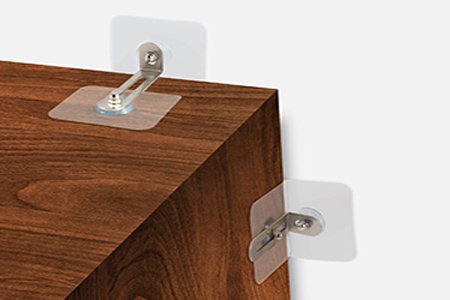
Most homeowners go with the option of using heavy-duty types of glue to secure their bookcase to the wall. Several heavy-duty adhesive clip brands are available from online retailers and your local hardware store. These clips either attach both to your bookshelf and the wall, or the wall alone like seen above.
It's probably the most affordable option of the four and easy enough to apply without experience working with the material. As a downside, heavy-duty adhesive can stick to paint, making it challenging to remove from the wall without damaging the paintwork.
Leaving a hole in the paint or plaster will send the landlord through the roof when you move out, and they might retain a portion of your security deposit for repairing the damage.
Mounting Method
- Choose the location to mount your bookshelf.
- Mark the location on the wall using a pencil.
- Rub the wall in the marked area to clean it off and provide better adhesion for the glue.
- Let the area gas off for ten minutes.
- Apply the glue to the wall and to the back of the shelf. Leave it to go tacky.
- Follow the pencil marks and press the bookshelf to the wall.
- Apply firm pressure to the shelf for a few minutes to allow the glue to stick.
- Apply masking tape to secure the shelf in place on the sides.
- Allow the adhesive to cure for around 24 hours, and remove the tape.
Remember to let the glue become tacky and make sure you hold it in place in some manner for 24 hours to let the adhesive cure. The right glue can absolutely secure a shelf to the wall without screws.
Option #2 – Heavy-Duty Double-Sided Carpenters Tape
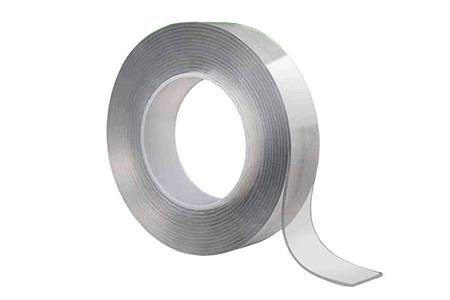
Our next method involves using heavy-duty builders or carpenters' tape. These types of tape are another viable option for securing the bookshelf to the wall without using fasteners. Many brands produce heavy-duty tapes for the job, and you'll find them online at your favorite retailer or at the local hardware store.
Heavy-duty tape anchors all types of furniture. From keeping your couch from slipping on the floor to securing bookshelves and other types of shelves, it's a handy product to keep around the house. Tape doesn't offer you a secure fit like glue, so it's the better choice for bookshelves that sit on the floor and need securing to the wall to prevent them from tipping over. If you can place it against the wall too, that's even better.
However, the glue can also lift paint and plaster from the wall, costing you some of your security deposit when it's time to move. Follow this method for securing the bookshelf to the wall using heavy-duty carpenters tape.
Mounting Method
- Choose where you want to place your bookshelf.
- Use a pencil to mark out the area.
- Use a cloth soaked with isopropyl alcohol to remove dirt and oils from the wall and the back of the bookshelf.
- Let surfaces gas off for 10 minutes.
- Remove one side of the tape backing and press the tape firmly on the wall using the line guides.
- Peel the other side of the tape, backing away, and press the bookshelf firmly against the wall for a few minutes.
- Test the tape's strength by firmly pushing the side of the bookshelf.
- If it stays put, you're good, but if it moves, you may have to press for another few minutes.
- If that doesn't work, repeat the process, and use more tape this time.
Don't be afraid to use more of this tape than you think you'll need. Yes, you might ultimately need to paint under the tape when you remove it, but that's better than your bookshelf tipping over, damaging the floor, and hurting anyone. This is an easy way to secure a bookshelf to the wall without screws, assuming it's not front heavy and not overly heavy.
Option #3 – Heavy-Duty Command Strips
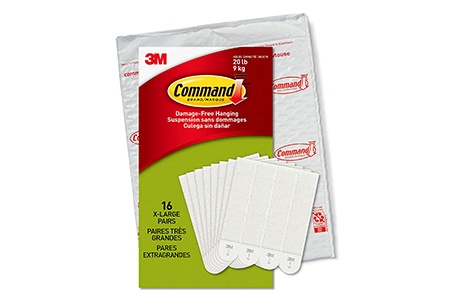
"Command Strips" is a 3M product under their Command brand readily available from online retailers and in most hardware stores. They are sort of like double-sided carpenter tape, but a more effective version and slightly more expensive. These strips come in different widths and lengths, up to 3 feet long and two inches wide. The heavy-duty options hold 20 lbs and you can use multiple of them.
They feature two plastic plates with Velcro on either plate to form a bond. A super-strong adhesive on the back of the plates is even more secure than carpenter's tape for hanging heavy objects like bookshelves.
These strips are easier to mount than tape or using glue. You can set them up on the wall and bookcase and lift the bookshelf into position. They're also easier to remove when your lease expires.
Run a hot hairdryer over them, and the glue melts away, allowing you to remove the strips without damaging the wall. They also come with a pull-tab that makes it simple as well. You might pay more for them upfront than other solutions, but they save you money on the backend when moving out of the apartment.
Mounting Method
- Choose where you want to place your bookshelf.
- Use a pencil to mark out the area.
- Use a cloth soaked with isopropyl alcohol to remove dirt and oils from the wall and the back of the bookshelf.
- Let surfaces gas off for 10 minutes.
- Add one strip to the wall and the other to the back of the bookshelf.
- Line them up using your pencil markings.
- Press the strips on the bookshelf onto the strips on the wall.
- Press firmly and walk back. Test the bookshelf to see if it's firmly in place.
- If not, remove it from the wall and add another Command Strip.
I'm of the opinion that more is merrier. Go ahead and use as many of these strips as you feel you need. Safety and security are worth it, so you might as well use any leftovers you have in the pack.
Option #4 – QDOS Anti-Tip Kit
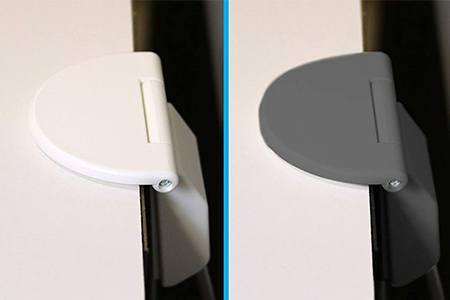
Our final option is using a Qdos Safety Anti-Tip Kit. This patent-pending system helps secure heavy furniture, preventing slipping, damage, and accidents around the home. It's inexpensive to purchase and supports weights up to 200 lbs, which should be adequate for your bookshelf.
The kit includes screws and adhesive, so you'll use the adhesive option. The Qdos Safety Anti-Tip Kit has straps similar to the Command Strips we discussed previously. However, this system doesn't use Velcro. It relies on hooks. It's also very adjustable and easy to remove from the wall when it's time to move out of your apartment.
Mounting Method
- Choose where you want to place your bookshelf.
- Use a pencil to mark out the area.
- Use a cloth soaked with isopropyl alcohol to remove dirt and oils from the wall and the back of the bookshelf.
- Let surfaces gas off for 10 minutes.
- Add one hook to the wall and the other to the back of the bookshelf.
- Line them up using your pencil markings.
- Press the hooks on the bookshelf onto those on the wall.
- Test the bookshelf to see if it's firmly in place.
- If not, remove it from the wall and add another QDOS tip.
Again we're using adhesives so make sure you press firmly and use any method to keep the glue firmly pressed so it can cure solidly. These are pretty reliable tools to secure a bookshelf to the wall without screws, especially if they aren't super heavy. They can stop a tip over, for sure.
How to Anchor Furniture to the Wall Without Drilling
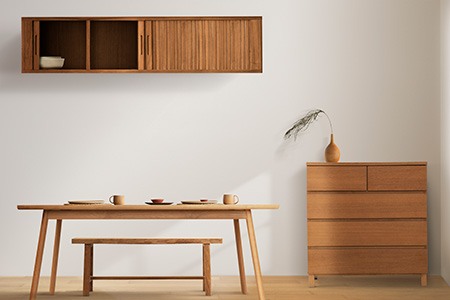
You have four options to hang a bookshelf without using screws. Heavy-duty glue and adhesive are affordable options but might damage the wall on removal. Command Strips and QDOS Tips are more expensive but easier to remove when it's time to vacate your property.
Follow our guides for easy installation in a few minutes. Remember to prepare the surface properly before fitting the bookshelf. And that's how to stabilize a bookshelf without drilling.
FAQs Regarding Securing a Bookshelf to a Wall Without Drilling
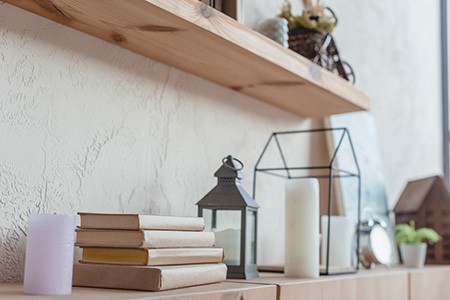
When the topic comes up of how to secure a bookshelf to a wall, there's always a bunch of related questions that arise. On the chance that you're wondering the same, we'll go ahead and answer them now.
Why Does My Bookshelf Lean?
Your bookshelf might be leaning forward because one of the legs is too short or because the bookshelf is too front-heavy when loaded with books. You can secure it to the wall using one of our four methods to prevent it from tipping forward and failing over. You can also use leveling shims to lift the leg or prevent the shelf from falling forward.
How Do I Stop My Standing Bookshelf From Falling Forward?
Securing the bookshelf to the wall is the best way to prevent it from falling forward. Using the shims mentioned above might not be enough to do the trick. If that's the case, one of our four methods of glue, tape, Command Strips, or QDOS Tips will help you secure the bookshelf.
Can I Use Studs to Anchor My Bookshelf to the Wall?
You can use studs if you own your home. If you're renting, the property management company or landlord will likely not want you drilling into the wall to mount the bookshelf. Ensure you ask for permission before doing so, or you risk losing your security deposit when you vacate the premises. Know that studs are 16 inches apart, which could cause you to need to slide your bookshelf over a bit.
How Do I Balance the Bookshelf?
You can use a spirit level to ensure your bookshelf is level and balanced. Ensure each side of the bookshelf has the same amount of books, and don't add too much weight to front, or it might tip over.
That's How to Stabilize a Bookshelf Without Drilling
There are methods to attach furniture to a wall without screws, and we've laid them out above. Some are going to be stronger than others, and some can tear out of the wall if you still have children trying to climb your bookshelves. But if they're left alone without pets and kids messing with them, all of these methods can be more than sufficient. And that is how to secure a bookshelf to the wall without screws.



